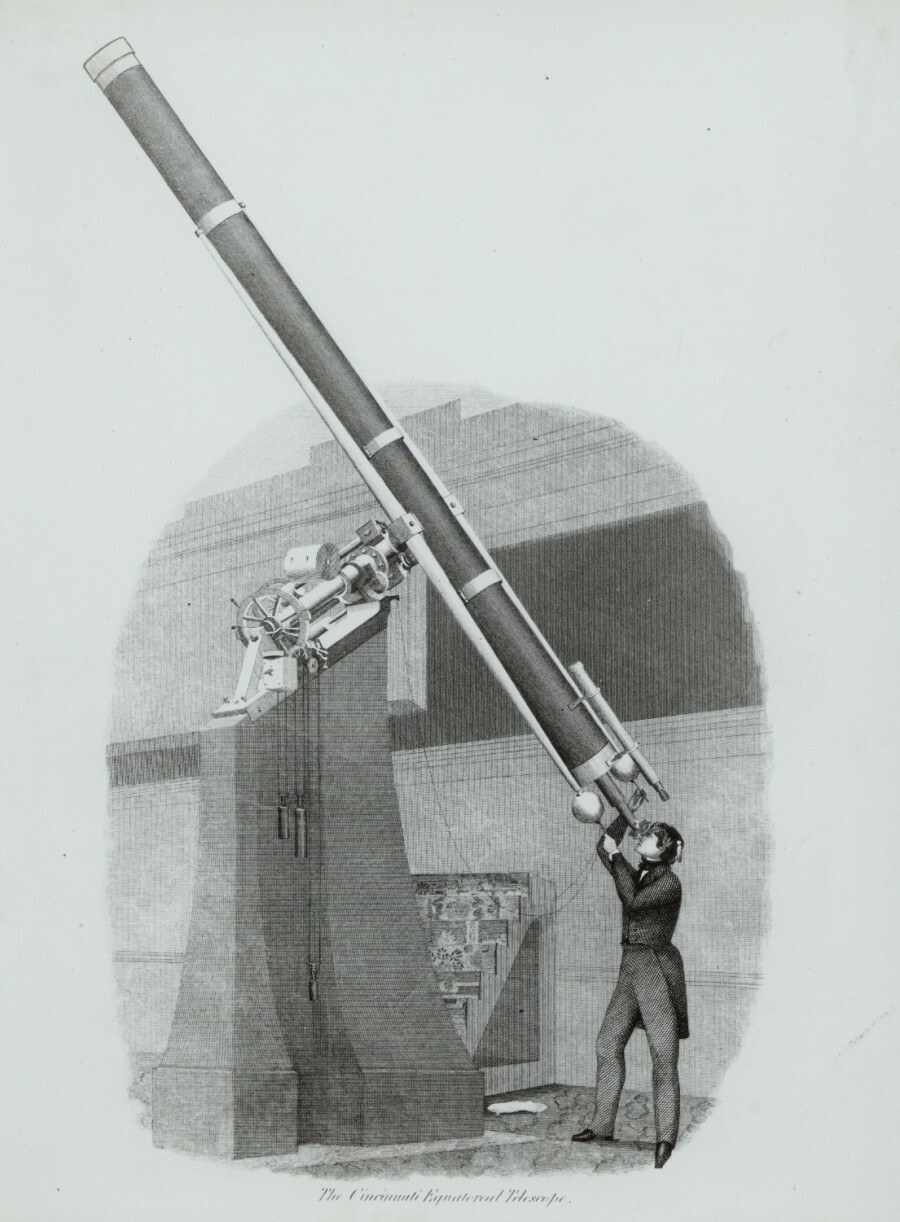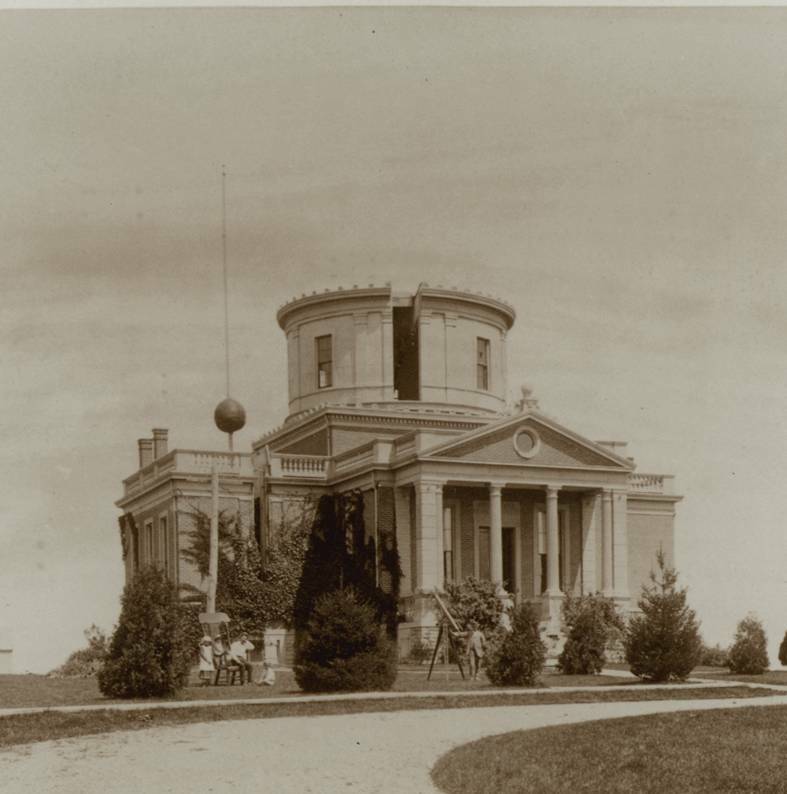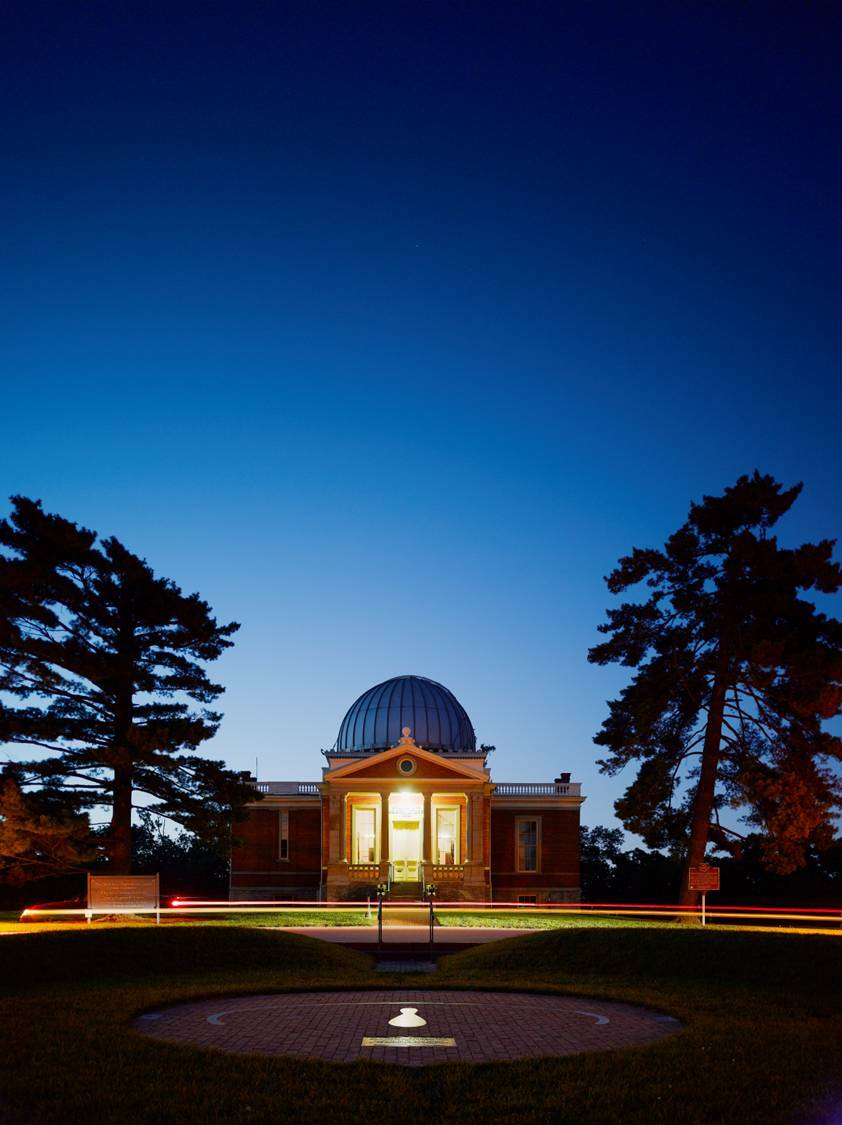About
Our History
The Birthplace of American Astronomy
Tucked away in a historic residential neighborhood of Cincinnati sit two buildings from a different era. When you drive up the narrow, tree-lined street past grand Victorian homes you feel the history in your bones. And at the end of the street stands the definition of “Observatory” – a picturesque jewel-box of a building capped by a silver dome.
The Cincinnati Observatory is known as ‘The Birthplace of American Astronomy.’ It houses one of the oldest working telescopes in the world and was the first public observatory in the western hemisphere. Recently restored to its original beauty, the Observatory is a fully functioning 19th century observatory used daily by the public and amateur astronomers. The main telescopes are an 11-inch Merz and Mahler refractor from 1845 and a 16-inch Alvan Clark and Sons refractor from 1904. The historic buildings are designated as a National Historic Landmark, and the grounds provide a serene, park-like setting while still being centrally located in the city of Cincinnati.

Founding and Early History
The old telescope in Cincinnati has always been the people’s telescope. In 1842, Cincinnati professor Ormsby MacKnight Mitchel was a dynamic, eloquent speaker and the first American populizer of astronomy – the Carl Sagan of the 1800s. Mitchel began raising money for the telescope and the observatory building. He went door to door soliciting $25 per person to invest in this new endeavor (that was the equivalent to an average monthly salary in 1842). Contributions came from all walks of life and every trade. In one month and a half, Mitchel raised nearly $7,500 – enough to start shopping around for a proper telescope in England and Europe. Finally in Munich, Bavaria (prior to a unified Germany) he discovered an 11-inch lens of incomparable quality that had already been ground but never installed. The tube was then constructed of brass and mahogany and the completed telescope was shipped via New Orleans, up the Mississippi and Ohio Rivers to downtown Cincinnati.
The observatory originally sat on four acres of land at the top of Mt. Ida, which was donated to the Society by Nicholas Longworth. On the 9th of November, 1843, a crowd of thousands witnessed former president John Quincy Adams preside over the dedication of the observatory, “The Lighthouse of the Sky,” and the laying of the cornerstone. It was at the dedication that Adams gave his last public speech. Mt Ida was renamed Mt. Adams following this event.
When the great refractor saw first light on April 14, 1845 it was the largest refractor in the Western Hemisphere and third largest in the world. Mitchel, the first director, wrote and edited the first astronomical publication in the United States, The Sidereal Messenger. The second director, Cleveland Abbe, published the nation’s first weather forecasts and he later assisted in the founding of the National Weather Service.
From the beginning the Cincinnati Observatory was unique. Not only could stockholders look through the telescope, but the general public could as well. Countless times Mitchel had his research interrupted by visitors who wanted to look through the refractor.
Current Observatory Trustee and neighbor, Charles Schiff has family ties to the early days of Cincinnati. “I think of my son, who comes from eight generations of Cincinnatians,” says Schiff. “His great-great-great-great-great grandfather-with whom he shares the same name-very likely looked through that very lens and saw the rings of Saturn just like my son did. That's a very visceral connection to his ancestry. Emotional, too, when you consider that they probably shared a similar reaction. You know, ‘Wow!’”
The History of the Observatory (YouTube Video ~30 minutes)

Move to Mt. Lookout
To get away from the pollution of downtown, the telescope moved in 1873 to a new settlement five miles east of the city. The area was renamed Mt. Lookout in honor of the new observatory. The four acres of land were donated by Board member John Kilgour. Kilgour also underwrote much of the construction of the new Observatory with a $10,000 donation. Architect Samuel Hannaford designed the Greek revival building before designing Cincinnati’s Music Hall and City Hall.
In 1904, the Observatory purchased a larger telescope from Cambridgeport Massachusetts, the 16 inch Alvan Clark and Sons refractor, and built another building on the campus. The older telescope from Munich moved into the new building and the newer telescope from Massachusetts went into operation in the old building.
Following World War II, the Cincinnati Observatory remained active due to the efforts of one of its directors, Dr. Paul Herget. Herget became one of the pioneers of the use of electronic computing machines for astronomical calculations. The International Astronomical Union Minor Planet Center was housed at the Cincinnati Observatory under the directorship of Herget from 1947 until his retirement in 1978. (more biographical information (pdf) on Dr. Herget from the National Academy of Sciences and PaulHerget.org.
In 1979 the Observatory formally became part of the Physics Department of the University of Cincinnati. The Observatory continued to be used for public education as well as for research by graduate students and others at the University of Cincinnati.

CENTER FOR ASTRONOMY EDUCATION
For decades the observatory sat idle as a research institution, its telescopes and buildings slowly deteriorating. In the 1980s both telescopes were painstakingly brought back into working order through the passion of the late astronomer, Paul Nohr. However in the 1990s the owners of the buildings, the University of Cincinnati, contemplated plans to sell the land to developers who were interested in leveling the site and erecting condos.
A coalition of neighbors, historians, preservation advocates, and amateur and professional astronomers took action to save the observatory. In 1999, the Cincinnati Observatory adopted a bold new mission. No longer would the observatory try to compete as a research facility, but resurrected itself as a center for astronomy education.
The proximity to an urban area no longer became a detriment, but provided a huge new audience. School groups and scouts tour day and night. Classes for all ages run weekly. Telescope training, star parties, weddings, art shows, fund raisers, business meetings, concerts, and movies are all held here. After a $2.5 million restoration and a renewed support from the University of Cincinnati and the larger community, the observatory suddenly became the place to be.
The Observatory’s educational programs utilize the Observatory and equipment for its STEM support in local K-12 schools. The staff has grown from 2 to 8 full-time employees and have a committed group of 100 volunteers. Each year the staff and volunteers reach 35,000 people on campus and through outreach to the community.
Eight generations of Cincinnatians have been able to look through the old telescope and experience the wonders of the universe. We hope to continue this tradition and welcome you to share in the history of the ‘Birthplace of American Astronomy.’


